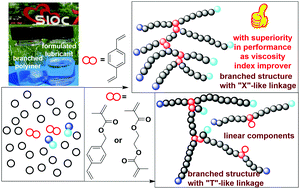Highly branched polymethacrylates prepared efficiently: brancher-directed topology and application performance†
Abstract
Highly branched polymers are very promising and suitable for a variety of applications. Herein, a series of oil-soluble and branched polymethacrylates are synthesized efficiently via atom transfer radical copolymerization of 2-ethylhexyl methacrylate (EHMA) with different divinyl branchers. More remarkably, for the first time, it is found that the brancher significantly affects not only the branching degree, but also the branch structure, thus determining the application performance of the branched polymethacrylates. The order of branching degree from high to low with the brancher is p-divinylbenzene (DVB) > ethylene glycol dimethacrylate > p-vinylbenzyl methacrylate. In addition, only the brancher DVB provides branched polymers with negligible linear components, further indicating that DVB is the most effective brancher. More interestingly, it is deduced that the brancher DVB produces branched polymers possessing “X”-like branch-linkages, while the other two branchers provide “T”-like linkages. These brancher effects could be well explained by the reactivity ratios of the different double bonds in the polymerization system. The polymethacrylates with “X”-like branch-linkages exhibit superiority in comprehensive performance as viscosity index improvers (VIIs) of lubricants compared to those with “T”-like linkages and linear polymers, including a commercial analogue. Among the branched polymers of EHMA, the EHMA/DVB copolymer achieves the best VI improving power and viscosity thickening capacity. More notably, this sample exhibits a unique performance of shear thickening and a negative shear stability index, which make it ideal for the potential applications as an additive of premium lubricants involving high shear stress.



 Please wait while we load your content...
Please wait while we load your content...